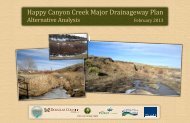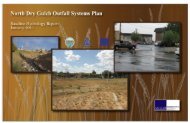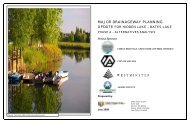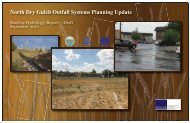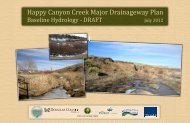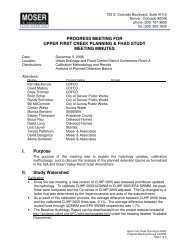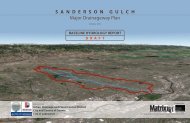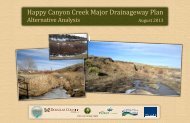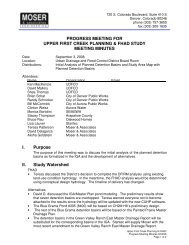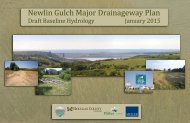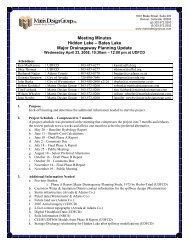Final Baseline Hydrology Report - October 2012 - Urban Drainage ...
Final Baseline Hydrology Report - October 2012 - Urban Drainage ...
Final Baseline Hydrology Report - October 2012 - Urban Drainage ...
You also want an ePaper? Increase the reach of your titles
YUMPU automatically turns print PDFs into web optimized ePapers that Google loves.
Sanderson Gulch Major <strong>Drainage</strong>way Plan<br />
<strong>Baseline</strong> <strong>Hydrology</strong> <strong>Report</strong> <strong>October</strong> <strong>2012</strong><br />
County of Denver Storm <strong>Drainage</strong> Design & Technical Criteria (January 2006). The City of Lakewood<br />
Storm <strong>Drainage</strong> Criteria provides only 2-hour depths and distributions for the 2-, 5-, 10-, 50- and 100-year<br />
events and these are slightly higher than both Denver and UDFCD criteria as shown in the appendix table.<br />
After discussions with the project sponsors, it was decided to use the UDFCD-USDCM rainfall values,<br />
given that the study area includes areas in both Denver and Lakewood, the Denver values yield lower<br />
flows, and the UDFCD-USDCM values are believed to be more precise for the project area. UDFCD time<br />
distributions of rainfall were also selected for use.<br />
3.3.2 Watershed Imperviousness<br />
A GIS-based approach was used to calculate the percent impervious area within the watershed. Zoning<br />
data provided by the City and County of Denver and the City of Lakewood was used in conjunction with<br />
Table RO-3 and Figures RO-3 through RO-5, from the UDFCD-USDCM, to generate percent impervious<br />
values for each zoning type. Table 3-3 lists each zoning type, the corresponding UDFCD land use<br />
description, and the associated percent impervious values used in the hydrologic model. GIS data<br />
representing the zoning-based imperviousness was intersected with the subbasin polygons to calculate<br />
area-weighted, or composite, percent impervious values for each subbasin. As previously described, the<br />
Sanderson Gulch watershed is essentially fully developed and the project sponsors elected to create only<br />
a future conditions model. The only significant future development anticipated is the redevelopment of the<br />
152-acre Green Gables Country Club. No existing conditions modeling was completed because of the<br />
insignificant change to the drainage basin.<br />
Table 3-3 Zoning-Based Impervious Summary<br />
Land Use Description<br />
% Imp.<br />
% of Watershed<br />
Area<br />
Business - Commercial Area 95% 2.9%<br />
Business - Neighborhood Area 85% 2.7%<br />
Industrial - Light Areas 80% 7.9%<br />
Open Space - Conservation 2% 0.0%<br />
Open Space - Park 5% 8.4%<br />
Residential - Apartments 80% 1.0%<br />
Residential - Multi-Unit (Attached) 75% 1.4%<br />
Residential - Multi-Unit (High Density) 66% 0.1%<br />
Residential - Multi-Unit (Low Density) 48% 0.5%<br />
Residential - Multi-Unit (Medium Density) 61% 0.2%<br />
Residential - Single-Family (Low Density) 28% 0.0%<br />
Residential - Single-Family ~3.6 DU/AC 42% 3.9%<br />
Residential - Single-Family ~4.2 DU/AC 43% 28.8%<br />
Residential - Single-Family ~4.8 DU/AC 45% 0.2%<br />
Residential - Single-Family ~5.1 DU/AC 45% 0.3%<br />
Residential - Single-Family ~7.3 DU/AC 48% 37.7%<br />
Residential - Single-Family ~9.7 DU/AC 55% 0.2%<br />
Water 100% 3.7%<br />
Basin input parameters including percent impervious for the Corrected (<strong>Baseline</strong>) <strong>Hydrology</strong> Model are<br />
provided in Appendix B Table B-5. Future conditions percent impervious values are illustrated for the<br />
watershed within the interactive <strong>Hydrology</strong> Map of Figure B-1 in Appendix B.<br />
3.3.3 Depression Losses<br />
Depression losses used are the same as the 1972 MDP. A pervious area value of 0.5 inches and an<br />
impervious depression loss of 0.1 inches were used for the entire watershed.<br />
3.3.4 Infiltration<br />
Modeling of infiltration utilized Horton’s Infiltration Equation. Initial and final infiltration rates and Horton’s<br />
decay rate were determined using Table RO-7 in the UDFCD-USDCM. For HSG C soils, the initial<br />
infiltration rate was 3.0 inches per hour, the final infiltration rate was 0.5 inches per hour. The decay<br />
coefficient was calibrated to 0.00111.<br />
3.3.5 Detention Ponds<br />
Typically UDFCD’s policy is to model only regional, publicly-owned facilities. However, the decision was<br />
made to include privately owned and maintained ponds since they were included in the previous study.<br />
Inadvertent detention areas were not modeled since their use and function cannot be predicted in the<br />
future.<br />
The following seven detention ponds were included in the 1972 and current updated baseline hydrology:<br />
1. Smith Reservoir, (private)<br />
2. Kendrick Reservoir,<br />
3. Jewell Park Reservoir,<br />
4. Green Gables Entrance Road,(private and has been enlarged to detain the excess runoff from<br />
the Green Gables Redevelopment)<br />
5. Clairefield Reservoir,<br />
6. Bit-O-Sea Reservoir, (private)<br />
7. Green Gable Park Pond<br />
In addition to these, four additional reservoirs have been included in the updated modeling:<br />
1. Kendrick Reservoir Number 1,<br />
2. Ward Reservoir Number 1,<br />
3. Ward Reservoir Number 5, and<br />
4. Harvey Park Lake<br />
These reservoirs and their tributary basins were excluded from the 1972 MDP because there is no outflow<br />
from these ponds for events up to at least the 100-year. Therefore, the results are the same whether they<br />
are in the model or excluded because they fully contain a 100-year event runoff without a discharge<br />
downstream. These four reservoirs have been included in the <strong>2012</strong> Corrected (<strong>Baseline</strong>) <strong>Hydrology</strong> Model<br />
to make all subbasins connected. These four reservoirs are filled by irrigation ditches and receive very<br />
little runoff from relatively small tributary areas and, consequently, have 100-year capacity. Agreements<br />
should be developed with the reservoir owners to ensure their long-term use for 100-year capacity storage<br />
of runoff is maintained.<br />
29



